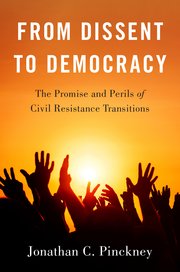On July 31, @JCPinckney, @EricaChenoweth, @Ras_Karya, @HardyMerriman, Huda Shafig and @USIP’s @MariaJStephan will discuss why some movement-driven transitions end in democracy and others don’t: https://t.co/KItDBpoK9V #PeoplePower4Peace
— U.S. Institute of Peace (@USIP) July 22, 2020
Nonviolent protest has proven to be a strong driver for democratization, and recent years have shown a rise in protest movements globally—from Hong Kong to Algeria to Sudan. Yet, popular uprisings don’t always lead to democratic transitions, as seen in the Arab Spring revolutions in Egypt or Yemen. Why do some transitions driven by movements end in democracy while others do not? USIP asks.
In the July issue of the NED’s Journal of Democracy, Erica Chenoweth asks why civil-resistance movements have been succeeding less often—and how the pandemic might save them.
 In his new book, “From Dissent to Democracy,” USIP’s Jonathan Pinckney systematically examines transitions initiated by nonviolent resistance campaigns and argues that two key factors explain whether or not democracy will follow such efforts:
In his new book, “From Dissent to Democracy,” USIP’s Jonathan Pinckney systematically examines transitions initiated by nonviolent resistance campaigns and argues that two key factors explain whether or not democracy will follow such efforts:
- First, a movement must sustain high levels of social mobilization.
- Second, it must direct that mobilization away from revolutionary “maximalist” goals and tactics and towards support for new institutions.







